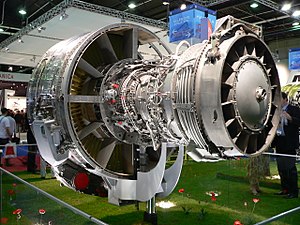
Back سي اف ام 56 Arabic CFM International CFM56 Catalan CFM International CFM56 Czech CFM International CFM56 German CFM International CFM56 Spanish سیافام اینترنشنال سیافام۵۶ FA CFM International CFM56 Finnish CFM International CFM56 French CFM International CFM56 GL CFM International CFM56 ID
| CFM56 | |
|---|---|

| |
| Rear view of a CFM56-5 | |
| Type | Turbofan |
| National origin | France / United States |
| Manufacturer | CFM International |
| First run | 20 June 1974[1] |
| Major applications | |
| Number built | 32,645 (June 2018)[2] |
| Developed from | General Electric F101 |
| Developed into | CFM International LEAP General Electric Affinity |
The CFM International CFM56 (U.S. military designation F108) series is a Franco-American family of high-bypass turbofan aircraft engines made by CFM International (CFMI), with a thrust range of 18,500 to 34,000 lbf (82 to 150 kN). CFMI is a 50–50 joint-owned company of Safran Aircraft Engines (formerly known as Snecma) of France, and GE Aerospace (GE) of the United States. GE produces the high-pressure compressor, combustor, and high-pressure turbine, Safran manufactures the fan, gearbox, exhaust and the low-pressure turbine, and some components are made by Avio of Italy and Honeywell from the US. Both companies have their own final assembly line, GE in Evendale, Ohio, and Safran in Villaroche, France. The engine initially had extremely slow sales but has gone on to become the most used turbofan aircraft engine in the world.
The CFM56 first ran in 1974. By April 1979, the joint venture had not received a single order in five years and was two weeks away from being dissolved. The program was saved when Delta Air Lines, United Airlines, and Flying Tigers chose the CFM56 to re-engine their Douglas DC-8 aircraft as part of the Super 70 program. The first engines entered service in 1982. The CFM56 was later selected to re-engine the Boeing 737. Boeing initially expected this re-engine program (later named the Boeing 737 Classic) to sell only modestly, but in fact the CFM56's lower noise and lower fuel consumption (compared to older engines for the 737) led to strong sales.
In 1987, the IAE V2500 engine for the A320, which had beaten the CFM56 in early sales of the A320, ran into technical trouble, leading many customers to switch to the CFM56. However, the CFM56 was not without its own issues; several fan blade failure incidents were experienced during early service, including one failure that was a cause of the Kegworth air disaster, and some CFM56 variants experienced problems when flying through rain or hail. Both of these issues were resolved with engine modifications.
- ^ "CFM56: One billion flight-hours, 20 milestones".
- ^ Cite error: The named reference
AvWeek16jul2018was invoked but never defined (see the help page).